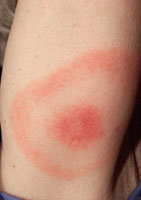 Fall is here! It’s time to start putting away yard equipment, watch the kids participate in outdoor sporting events or a stroll through the many scenic parks or wooded neighborhoods throughout Pennsylvania, New Jersey, Maryland, Delaware, and New York. It’s also tick season. Yes, even they have a season.
Fall is here! It’s time to start putting away yard equipment, watch the kids participate in outdoor sporting events or a stroll through the many scenic parks or wooded neighborhoods throughout Pennsylvania, New Jersey, Maryland, Delaware, and New York. It’s also tick season. Yes, even they have a season.
Early to late spring and fall are the times when ticks emerge looking for a blood meal. The tick most often associated with Lyme disease is the deer tick, though all ticks can carry a number of other diseases that can be transmitted to humans. Deer ticks are small, about the size of a pinhead, making them difficult to find once attached. Other ticks such as the dog tick and the Lone Star tick are larger, but can infect you more quickly than the deer tick.
Lyme disease ticks waiting in the bush
Ticks are found in low-lying brush, grass or shrubs, and will attach to the unaware host as he or she walks by. Ticks crawl upward on their host until they reach an impediment to their progress that they cannot overcome. Common areas of attachment are behind the knee, groin, waistline, armpit, or scalp. They attach by piercing the skin with a mouthpiece after secreting an anesthetic from their salivary gland. Attaching pain free, in an out of sight area is how the ticks avoid detection. Once attached, blood is siphoned from the host, mixed in the tick’s mid-gut and the tick regurgitated back into the host. The tick may need to be attached for up to 24 hours for the person to be infected, but it can occur even within a few hours.
Caution when removing deer tick
It is important that when a tick is removed that it is not crushed or burned. It should be grasped firmly by its mouthpiece with a forceps and pulled out. If part of the mouthpiece remains in your skin, consult with a physician for further removal. There is no effective means of immediately identifying an infected Deer tick from an uninfected one at the time of removal. The onset of symptoms can vary and may be delayed. It is currently recommended that all patients who have a Deer tick bite should receive preventive antibiotic therapy, so taking a wait-and-see attitude before reporting it to your family physician can be dangerous.
 Lyme disease symptoms
Lyme disease symptoms
Lyme disease symptoms are divided into two distinct stages called Early and Late disease. Early localized disease often starts with flu-like feelings of headache, muscle and joint and neck stiffness, low-grade fever and fatigue. Less than 80 percent of patients develop an Erythema Migraines rash or “Bulls Eye” rash. This rash is proof of Lyme disease and always occurs at the bite site. It appears anywhere from 3 days to 3weeks after an exposure, expands outward from a clear center with red outer border and may or may not be accompanied by other symptoms. This rash typically lasts 2-4 weeks and disappears on its own. While a physician can confirm a case of Early Lyme disease with this finding, it is the least common type of rash that occurs with Lyme disease! Taking a picture of the rash before it disappears is extremely important in helping your physician to make an accurate diagnosis.
Symptoms associated with Early and Late Lyme Disease are Bell’s Palsy, tingling sensations of the upper and lower extremities, severe headaches, problems with short term memory, diminished concentration and speech disturbances. Other complaints may be visual disturbances, neck stiffness, cardiac or pulmonary complaints, chronic fatigue, insomnia, depression or anxiety issues.
Lyme testing
Testing for Lyme disease is traditionally performed using two tests called the ELISA and Western Blot. When positive they can confirm a case of Lyme disease, but they can be negative in up to 7 out of 10 patients who are truly infected. There are newer tests such as the C6 Peptide ELISA for Lyme disease and PCR, a genetic test, which can assist the physician in making the diagnosis in more difficult to diagnose patients. (See Accurate Lyme Diagnosis)
Fortunately, the Haverford Wellness Center under the direction of Domenic Braccia D.O. is dedicated to the accurate diagnosis and reasonable treatment of Lyme disease and other tick borne diseases. Dr. Braccia, and the sof the Haverford Wellness Center are fully equipped and capable of managing aspects of Lyme disease and the other tick borne diseases from prevention and management of early disease to the complex diagnostic and therapeutic cases. These cases include treatment failures, and late stage Lyme disease patients who have been ill for many years.


